Gniezno cathedral
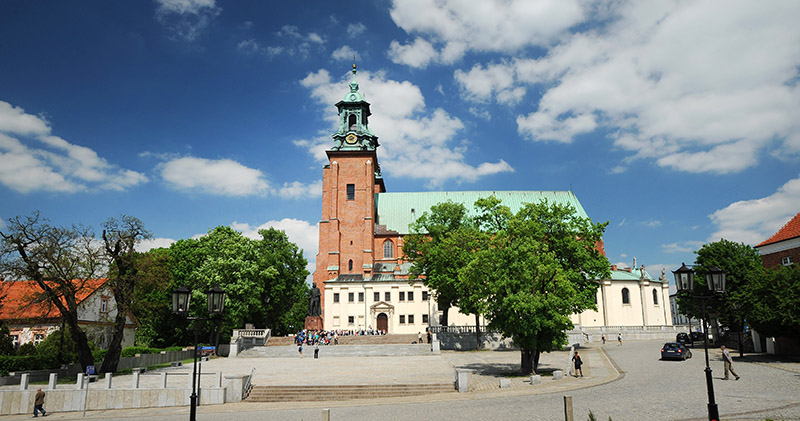 Gniezno cathedral, photo: Wojciech Stróżyk / Reporter
Gniezno cathedral, photo: Wojciech Stróżyk / ReporterThe Gniezno cathedral, the Mother of Polish Churches, stands on the Wzgórze Lecha (Hill of Lech). Evocative of French architecture, the shrine’s present shape was raised in the 14th century as the fourth structure on site. The first was built in the 9th century, the subsequent one – a century later. Built on the scheme of a cross by Duke Mieszko I, and serving as the tomb of his wife Dobrawa, the cathedral was also later rebuilt by Bolesław the Brave. It was here that the burial ceremony of Poland’s patron, St. Wojciech took place. The silver coffin with his relics is still kept in the cathedral to date.
Through renovations that followed a series of fires, the cathedral took on Baroque and classicist forms, to be later finally reconstructed in the Gothic spirit after World War II.
Its mighty towers stand high above the 85-metre walls and have Baroque tented roofs. The main nave and the side naves are surrounded by a wreath of 14 chapels, most of them Gothic. The porch by the southern tower houses one of Poland’s most precious relics of Romanesque art – the bronze, late 12th-century Gniezno Doors. The cathedral also contains many other valuable works of art and beautiful architectural details (such as the tombstone of Zbigniew Oleśnicki carved by Wit Stwosz).
The first coronation ceremonies of Polish kings were held at the Gniezno cathedral.
At the millennial anniversary of the Gniezno gathering, representatives from countries bound to the mission of St. Wojciech planted symbolic trees in the Valley of Reconciliation.
The cloister church in Sulejów
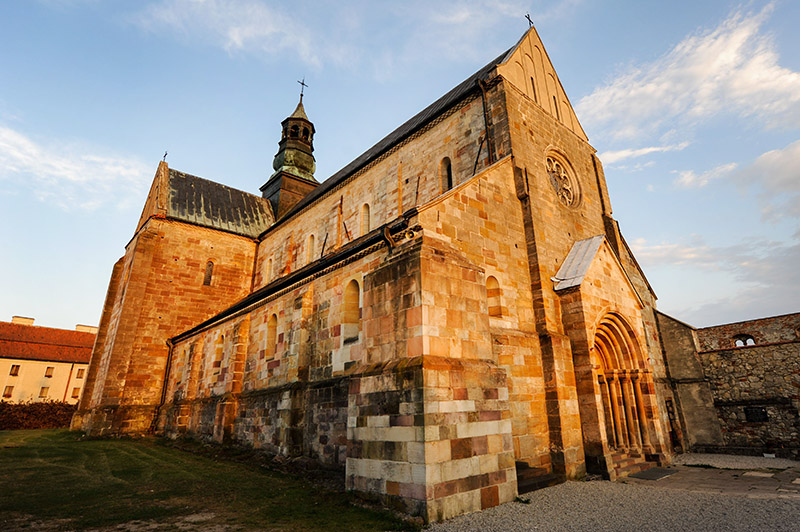 The church of St. Thomas of Canterbury in Sulejów, photo: Gerard/Reporter
The church of St. Thomas of Canterbury in Sulejów, photo: Gerard/ReporterSulejów is the best preserved Cistercian fortified abbey in Poland. Legend links the founding of the cloister with a hunt by Prince Kazimierz II Sprawiedliwy (the Just). While chasing after a stag, the prince got separated from his companions and as he was trying to find his way back to them he heard a voice from the sky ‘Raise a church in this place, and I will return you to your servants.’ The ruler promised to fulfil the will of God, and twelve lions led him back to his court.
The church of St. Thomas of Canterbury was raised with high-quality sandstone from the Szydłowice region in the first half of the 13th century. The three-nave transept basilica is build in a Romanesque and Gothic style. Its chapter house is covered over with a groin-rib vault, the four spans of which all lean on one column – one of the most daring constructions of its kind in Poland. Inside, there are five Baroque altars and a rococo main altar, raised in 1788 by Jan Millman. The wooden sculptures of lions surrounding are evocative of the church’s founding legend.
Pelplin cathedral
 The cathedral of the Assumption of Blessed Virgin Mary in Pelplin, photo: Przemek Świderski / Reporter
The cathedral of the Assumption of Blessed Virgin Mary in Pelplin, photo: Przemek Świderski / ReporterThe small town of Pelplin in the Kociewie region hides one of the most monumental sites of Gothic architecture in Poland. The three-nave and one-span cathedral basilica of the Assumption of Blessed Virgin Mary was raised at the turn of the 13th and 14th centuries, and its construction continued through to the 16th century.
Among the preserved elements of its original construction are the late-Gothic choirs (built between 1450-1462). The oak benches are decorated with figures (with a rare depiction of the Holy Spirit as a man) and ornate floral compositions. There are also the magnificent Baroque organs, as well as diamond, rib and star-vault ceilings, and an exceptional number of altars. The 23 of them are made of wood, marble and stucco. The most precious altar is the main one, raised in a mannerist style, gilded, and richly decorated with the paintings of Hermann Han. The five storeys of the church are 25 metres tall, making it the tallest church of its kind in this part of Europe.
The local Diocese Museum keeps numerous unique incunabula, among them one of the twenty copies of the Gutenberg Bible that exist in the world (and the only copy on Polish territory). Pilgrims are also attracted by the so-called pelplinki, a regional speciality – creamy caramel cookies with honey.
Wawel cathedral
 Wawel cathedral, photo: Waldek Sosnowski / Forum
Wawel cathedral, photo: Waldek Sosnowski / ForumThere could hardly be a more exemplary monument of Polish culture, history, and faith than Wawel cathedral. 37 coronation ceremonies took place here, beginning with the crowning of Władysław Łokietek in 1320. Almost all of Poland’s rulers have been buried at the cathedral. The crypts of the church also serve as burial sites for national heroes, among them Tadeusz Kościuszko and Józef Piłsudski, and a Bards’ Crypt houses the tombs of Adam Mickiewicz and Julisz Słowacki. There is also the grave of St. Stanislaw, whose cult is linked with the idea of a united and independent Polish State.
We know little about what the first cathedral church was raised in Wawel looked like. It was probably built shortly after the founding of the Kraków bishopric in the year 1000. After yet another Romanesque cathedral was raised at the turn of the 11th and 12th centuries, the crypt of St. Leonard remained as well as the lower part of the Silver Bells’ towers. The 14th century three-nave transept basilica we know today was rebuilt numerous times over the centuries.
Currently, there are 19 Gothic, Renaissance, and Baroque chapels, with the prominent Zygmunt Chapel probably the most famous among them. The sound of a bell founded by King Zygmunt I the Old resonates from the cathedral during important state and church ceremonies. Tradition has it that the sound of the bell makes the clouds disperse and the sun appear. The decorative, cast-iron doors that lead into the cathedral date back to the epoch of the last Piast rulers.
St. Mary’s Basilica in Kraków
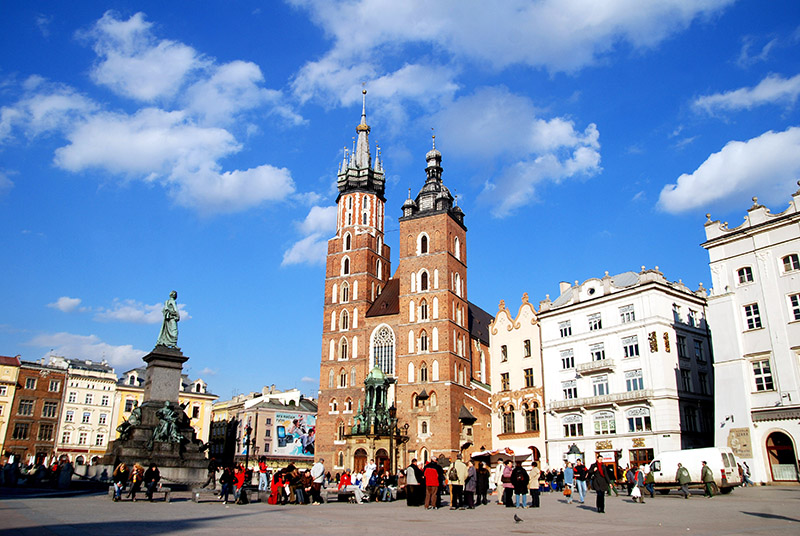 St. Mary’s Basilica in Kraków, photo: Andrzej Rubis / Forum
St. Mary’s Basilica in Kraków, photo: Andrzej Rubis / ForumThe second most important shrine in Poland’s former capital is the church of the Assumption of the Blessed Virgin Mary. Its original building was raised before Kraków was officially endowed with city rights in 1257, and this explains its asymmetrical placement with respect to the axis of the Main Square. The original Romanesque building was destroyed during the Tatar invasions, and its traces are now preserved 2.6 metres underground.
The clay brick three-nave Gothic basilica of today was built in the late 14th century. Over the subsequent 100 years chapels were added onto the side naves, and later the work concentrated on renovating the interiors. Franciszek Placidi dared a brutal intervention into the Gothic original in the 18th century, but later the form was partially brought back to the preceding Gothic style. Among those who took on the task of this re-Gothicising the cathedral was the artist Jan Matejko (who painted the starry polychromic vault ceiling) and his students – Stanisław Wyspiański and Józef Mehoffer, who created separate stein-glass designs. St. Mary’s Basilica is associated first and foremost with Wit Stwosz, the creator of St. Mary’s Altar, one of the most prominent and best preserved works of late Gothic sculpture in this part of Europe.
Two towers of unequal height are another distinct element that captures attention. The tent-roofed hejnał (hymn) tower measures 81 metres together with its spire, while the bell tower is 69 metres high. According to legend, two brothers worked on the construction of the towers. One of them stabbed the other for fear of the other's tower becoming taller than his own. Filled with remorse, he took his own life soon afterwards. The murder weapon still hangs in one of the Sukiennice gates.
St. Mary’s Church in Gdańsk
 St. Mary’s Church in Gdańsk, photo: Wojciech Stróżyk / Reporter
St. Mary’s Church in Gdańsk, photo: Wojciech Stróżyk / ReporterThe massive tower of the co-cathedral St. Mary’s church stretches up above the panorama of Gdańsk and the spacious surroundings. It is said to be the largest brick shrine in Europe. Capable of holding 25 thousand people, the cathedral would have once been able to host the entire population of the city – it was, in fact the case at the time when it was raised. Its completion took some 160 years (1343-1502). During the preceding era of the Pomeranian princes, a small wooden church stood in its location.
The basilica, also known as the Crown of Gdańsk, managed to keep its historic form in spite of a tumultuous history. Its iconography dates back to the 16th century, and its bright interiors are filled with pillars that support a star-vault, rib-vault and diamond-vault structured ceiling. The main altar of the church is made of oak in a late-Gothic style, and it was build in the years 1510-1517. A famous reconstructed 15th-century astronomic clock stands near the sacristy, and the interiors also boast a 19th-century replica of Hans Memling’s Last Judgement. A statue of the so-called Beautiful Gdańsk Madonna stands in the chapel of St. Anne. Legend has it that a young man carved it all in one night whilst he was locked up in a cell. The magnificent work of art bought him freedom, and it later turned out that he had in fact been imprisoned unjustly.
The post of local bandmaster at St. Mary’s church in Gdańsk was once a real honour, (and a very well-paid job), and the composer Johann Sebastian Bach himself is known to have once applied for it. A letter from 1730 has been preserved, in which Bach asks a friend to consider his chances at getting the job.
St. Anne’s Basilica in Kodnio
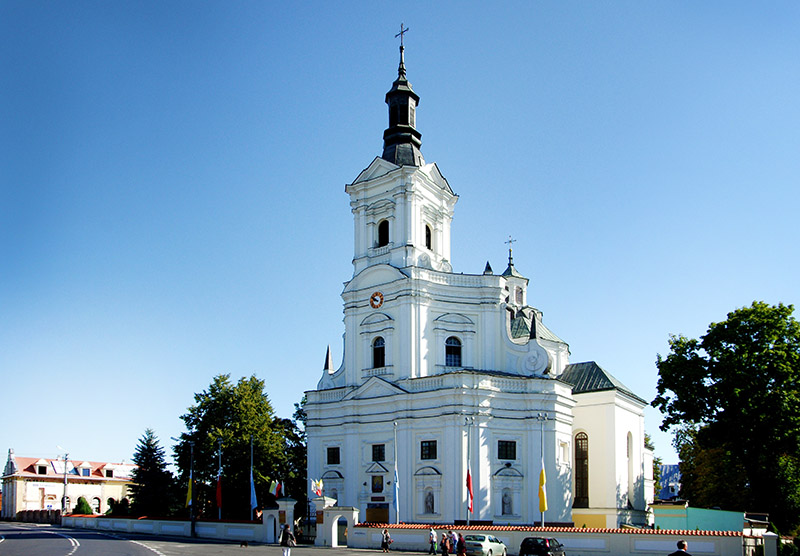 St. Anne’s Basilica in Kodnio, photo: Marek Bazak / East News
St. Anne’s Basilica in Kodnio, photo: Marek Bazak / East NewsHoly Mary stands against the background of a rainbow aureola, holding the Baby Jesus in her left arm and bearing a sceptre in her right. This image, which portrays an original sculpture of the Madonna from Guadeloupe, was stored at the papal chapel. In 1631, Mikołaj Pius Sapieha, the grand ensign of Lithuania, was miraculously healed during a mass service conducted in the presence of this painting. Sapieha, the owner of Kodnio, showed his gratitude for divine mercy in a peculiar way – having failed to obtain the permission of Pope Urban VIII to take the painting, he simply stole it.
The painting was first hung in the castle chapel and later moved to the church of St. Anne in Kodnio, in the Podlasie region. Sapieha had the Kodnio church raised in 1629, modelled on St. Peter’s Basilica in Rome. The shrine, whose construction took six years, was originally built in a late-Renaissance style, which today is covered over by a Baroque façade. Sapieha had himself buried under a nameless plaque of red granite in the church’s porch, in order for the feet of the faithful to step over his grave. The story of the miraculous painting inspired a novel by Zofia Kossak-Szczucka, entitled Błogosławiona wina (editor's translation: Blessed Sin).
Churches of Peace in Jawor and Świdnica
 Church of Peace in Jawor, photo: Wojciech Wojcik / Forum
Church of Peace in Jawor, photo: Wojciech Wojcik / ForumThey had to be situated far from the city walls, built with temporary materials (wood, clay, and straw), and they could not resemble traditional churches. Such were the conditions proclaimed by Ferdinand III Habsburg under which he allowed Silesian Lutherans to raise protestant churches. They were to symbolise religious tolerance, and crown the ending of the The Thirty Years’ War. And yet, two of the three churches (excluding the one in Głogów) still stand unmoved to this day, some 350 years later. In 2001, they were added to the UNESCO World Heritage list.
The Churches of Peace in Jawor (1654-55) and in Świdnica (1656-57), 30km away from each other, are the largest sacral monuments in Europe raised in the timber-framing technique. Designed by the Wrocław-based architect Albrecht von Säbisch, they look very modest from the outside, while their Baroque interiors resemble theatres, with multi-storied matroneums. The interiors of the Jawor shrine are decorated with 180 paintings, depicting scenes from the Old and the New Testament, while those in Świdnica represent apocalyptic visions as well as a panorama of the surrounding towns.
Basilica in Święta Góra
 Basilica in Święta Góra (near Gostyń), photo: Marek Maruszak / Forum
Basilica in Święta Góra (near Gostyń), photo: Marek Maruszak / ForumIts founder – Adam Konarzewski – wanted the basilica to resemble the Kraków Church of St. Peter and St. Paul. After the founder’s death, his wife Zofia nee Opalińska continued his endeavour. She changed her project under the influence of a journey to Italy. The round basilica with a huge copula (17 metres in diameter, 50 metres in height) is a replica of the Venetian Santa Maria della Salute.
The cult of Holy Mary had been developing in Święta Góra since the 14th century, but the magnificent shrine was raised later, in the years 1675-1698, in accordance with the design by Italian architect Baldassare Longhena. Its interiors were given a Baroque and rococo style (with elements such as marble altars and polychromes in the dome depicting scenes from the life of St. Filip Neri). The main altar has a painting of Holy Mary with Child (the Świętogóra Spiritual Rose) and the side altar – a Gothic-renaissance sculpture of Mater Dolorous. During the period of the reformation, Anna Gostyńska ordered for the figure to be chopped up and burned, but neither axe nor fire were capable of touching it. The statue was tossed in a well. It was found a dozen years later, thanks to a bright hue that emerged above the well. The statue was once again placed inside the church.
The Łemko tserkva in Kwiatoń
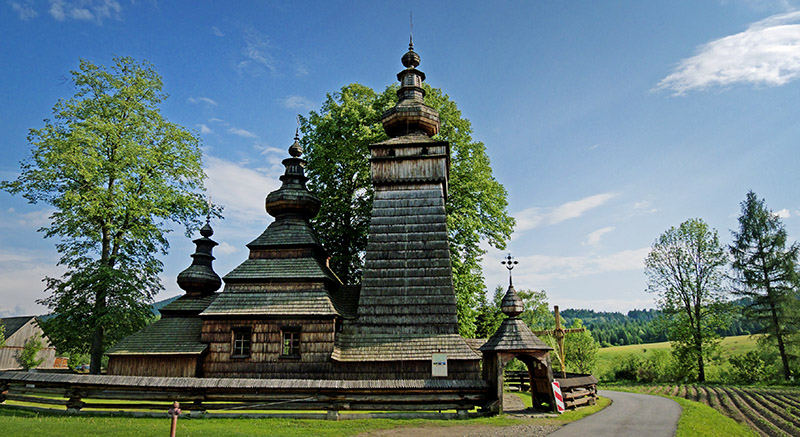 St. Paraskeva Church in Kwiatoń, photo: Dawid Lasociński / Forum
St. Paraskeva Church in Kwiatoń, photo: Dawid Lasociński / ForumThe St. Paraskeva Greek Orthodox church in the lower Beskidy mountains is not only one of the most beautiful wooden shrines in Poland, but also a unique manifestation of the way in which Eastern and Western influences are intertwined in the country. It was created by the Greek Orthodox Łemko minority who had developed their own unique style of church construction. The church is said to have been founded in 1700. Its traditional, lengthy main body was enlarged by adding on a tower in 1743. The tower is modelled on those found in churches across the Małopolska region.
The wooden construction (made mostly of fir and also with spruce) has undergone a couple of renovations. The interior is now maintained in the tradition of the late Baroque. The presbytery and a decorative framing of the windows are separated from the main nave by the iconostasis painted by Michał Bogdańsi in 1904. Its wall paintings imitate marble columns and cornices.
Ever since the ‘Wisła’ resettlements action in 1947, the shrine has served Catholics. In 2013, it was added to the UNESCO heritage list.